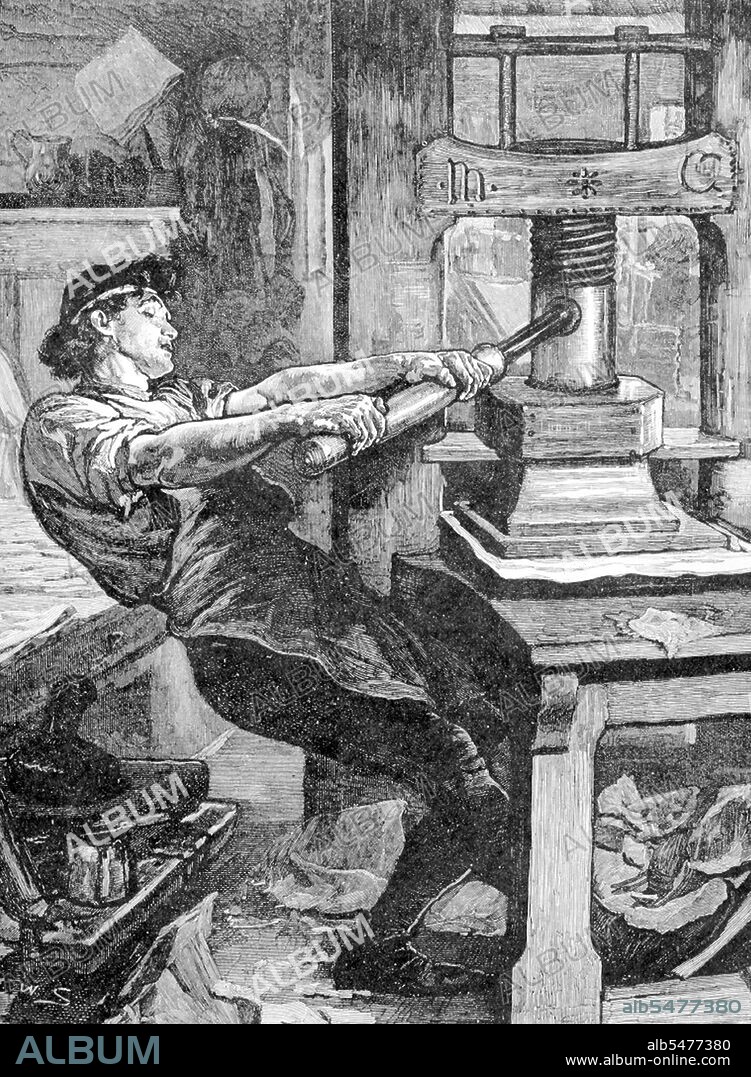alb5477380
Europe-Germany: A mechanical printing press of the type designed by Johannes Gutenberg,19th century representation

|
Añadir a otro lightbox |
|
Añadir a otro lightbox |



¿Ya tienes cuenta? Iniciar sesión
¿No tienes cuenta? Regístrate
Compra esta imagen.
Selecciona el uso:

Título:
Europe-Germany: A mechanical printing press of the type designed by Johannes Gutenberg,19th century representation
Descripción:
Traducción automática: Johannes Gensfleisch zur Laden zum Gutenberg fue un herrero, orfebre, impresor y editor que introdujo la imprenta. Su uso de la impresión de tipos móviles inició la Revolución Imprenta y es ampliamente considerado como el evento más importante del período moderno. Desempeñó un papel clave en el desarrollo del Renacimiento, la Reforma y la Revolución Científica y sentó las bases materiales para la economía moderna basada en el conocimiento y la difusión del conocimiento entre las masas. Gutenberg fue el primer europeo en utilizar la impresión de tipos móviles, alrededor de 1439. Entre sus muchas contribuciones a la imprenta se encuentran: la invención de un proceso para la producción en masa de tipos móviles; el uso de tinta a base de aceite; y el uso de una imprenta de madera similar a las prensas de tornillo agrícolas de la época. Su aclamación se debe a la ingeniería de estos elementos en un sistema práctico para la producción en masa de libros impresos, que era económicamente viable tanto para impresores como para lectores. El método de Gutenberg para fabricar tipos es una mejora con respecto al del chino Bi Sheng de 400 años antes, y tradicionalmente se considera que incluía una aleación de metal tipo y un molde manual para fundir tipos. El uso de tipos móviles metálicos duraderos permitió una rápida producción en masa de obras impresas. La tecnología de impresión de Gutenberg se extendió rápidamente por toda Europa y rápidamente reemplazó a la mayoría de los métodos de producción de libros manuscritos en todo el mundo. La impresión en madera, la rubricación y el grabado continuaron utilizándose para complementar el proceso de impresión de Gutenberg. Su primera obra importante utilizando sus métodos de impresión fue la Biblia de Gutenberg.
Johannes Gensfleisch zur Laden zum Gutenberg was a blacksmith, goldsmith, printer, and publisher who introduced the printing press. His usage of movable type printing started the Printing Revolution and is widely regarded as the most important event of the modern period. It played a key role in the development of the Renaissance, Reformation and the Scientific Revolution and laid the material basis for the modern knowledge-based economy and the spread of learning to the masses. Gutenberg was the first European to use movable type printing, in around 1439. Among his many contributions to printing are: the invention of a process for mass-producing movable type; the use of oil-based ink; and the use of a wooden printing press similar to the agricultural screw presses of the period. His acclaim is due to the engineering of these elements into a practical system for the mass production of printed books, that was economically viable for printers and readers alike. Gutenberg's method for making type is an improvement over the Chinese Bi Sheng's from 400 years earlier, and is traditionally considered to have included a type metal alloy and a hand mould for casting type. The use of durable metallic movable type allowed rapid mass production of printed works. Gutenberg's printing technology spread rapidly throughout Europe, and quickly replaced most of the handwritten manuscript methods of book production throughout the world. Woodblock printing, rubrication, and engraving continued to be used to supplement Gutenberg's printing process. His first major work using his printing methods was the Gutenberg Bible.
Crédito:
Album / Pictures From History/Universal Images Group
Autorizaciones:
Tamaño imagen:
3574 x 4873 px | 49.8 MB
Tamaño impresión:
30.3 x 41.3 cm | 11.9 x 16.2 in (300 dpi)
Palabras clave:
AGUAFUERTE • ALEMANIA • CIENCIA • CIENCIAS • ENGRAVING • ESCRITURA • EUROPA • GRABADO • GRABADOS • HISTORIA • HISTORICO • IMPRESION • IMPRIMIR • JOHANNES GUTENBERG • LITERATO • LITERATURA • LITERATURE • TECNOLOGÍA


 Pinterest
Pinterest Twitter
Twitter Facebook
Facebook Copiar enlace
Copiar enlace Email
Email
